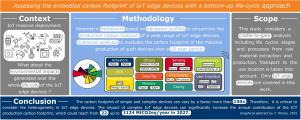Journal of Cleaner Production ( IF 9.7 ) Pub Date : 2021-09-10 , DOI: 10.1016/j.jclepro.2021.128966 Thibault Pirson 1 , David Bol 1

|
In upcoming years, the number of Internet-of-Things (IoT) devices is expected to surge up to tens of billions of physical objects. However, while the IoT is often presented as a promising solution to tackle environmental challenges, the direct environmental impacts generated over the life cycle of the physical devices are usually overlooked. It is implicitly assumed that their environmental burden is negligible compared to the positive impacts they can generate. Yet, because IoT calls for a massive deployment of electronic devices in the environment, life-cycle assessment (LCA) is an essential tool to leverage in order to avoid further increasing the stress on our planet. Some general LCA methodologies for IoT already exist but quantitative results are still scarce. In this paper, we present a parametric framework based on hardware profiles to evaluate the cradle-to-gate carbon footprint of IoT edge devices. We exploit our framework in three ways. First, we apply it on four use cases to evaluate their respective production carbon footprint. Then, we show that the heterogeneity inherent to IoT edge devices must be considered as the production carbon footprint between simple and complex devices can vary by a factor of more than . Finally, we estimate the absolute carbon footprint induced by the worldwide production of IoT edge devices through a macroscopic analysis over a 10-year period. Results range from 22 to 562 MtCO2-eq/year in 2027 depending on the deployment scenarios. However, the truncation error acknowledged for LCA bottom-up approaches usually lead to an undershoot of the environmental impacts. We compared the results of our use cases with the few reports available from Google and Apple, which suggest that our estimates could be revised upwards by a factor around to compensate for the truncation error. Worst-case scenarios in 2027 would therefore reach more than 1000 MtCO2-eq/year. This truly stresses the necessity to consider environmental constraints when designing and deploying IoT edge devices.
中文翻译:

使用自下而上的生命周期方法评估物联网边缘设备的隐含碳足迹
在未来几年,物联网 (IoT) 设备的数量预计将激增至数百亿个物理对象。然而,虽然物联网通常被认为是应对环境挑战的有前途的解决方案,但在物理设备的生命周期中产生的直接环境影响通常被忽视。隐含地假设,与它们可以产生的积极影响相比,它们的环境负担可以忽略不计。然而,由于物联网需要在环境中大规模部署电子设备,因此生命周期评估 (LCA) 是一种必不可少的工具,可以利用它来避免进一步增加地球上的压力。一些用于物联网的通用 LCA 方法已经存在,但定量结果仍然很少。在本文中,我们提出了一个基于硬件配置文件的参数化框架来评估物联网边缘设备从摇篮到大门的碳足迹。我们以三种方式利用我们的框架。首先,我们将其应用于四个用例,以评估它们各自的生产碳足迹。然后,我们表明必须考虑物联网边缘设备固有的异质性,因为简单和复杂设备之间的生产碳足迹可能相差超过. 最后,我们通过 10 年的宏观分析估算了全球生产物联网边缘设备引起的绝对碳足迹。根据部署场景,2027 年的结果范围为 22 至 562 MtCO2-eq/年。然而,LCA 自下而上方法所承认的截断错误通常会导致环境影响不足。我们将我们的用例结果与 Google 和 Apple 提供的少数报告进行了比较,这表明我们的估计可以向上修正大约一个因子以补偿截断误差。因此,2027 年的最坏情况将达到 1000 MtCO2-eq/年以上。这确实强调了在设计和部署物联网边缘设备时考虑环境约束的必要性。









































 京公网安备 11010802027423号
京公网安备 11010802027423号